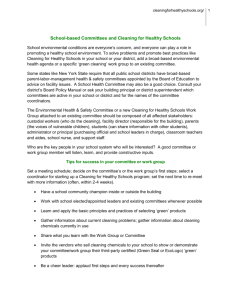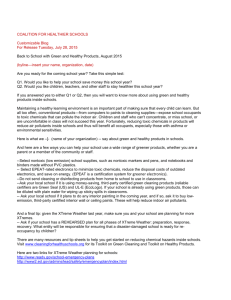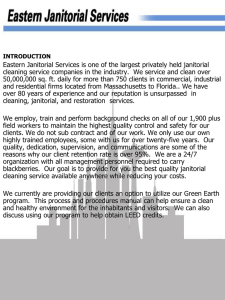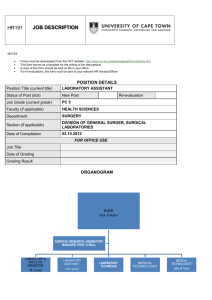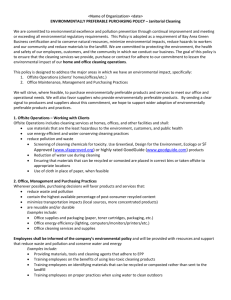Green Cleaning Policy
advertisement
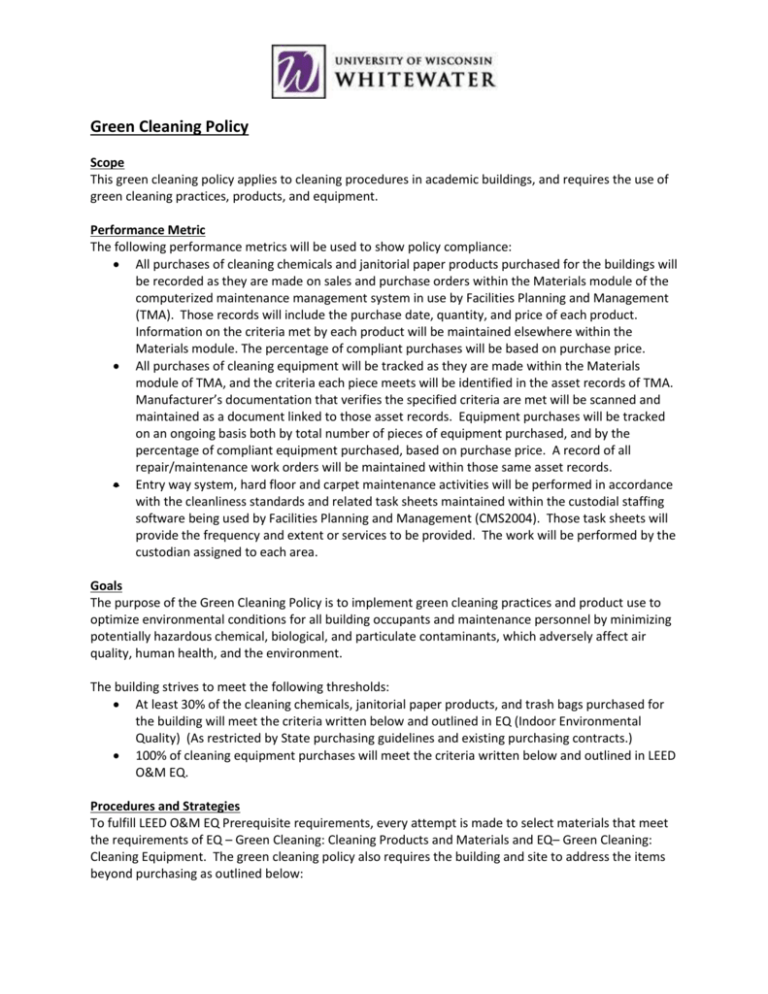
Green Cleaning Policy Scope This green cleaning policy applies to cleaning procedures in academic buildings, and requires the use of green cleaning practices, products, and equipment. Performance Metric The following performance metrics will be used to show policy compliance: All purchases of cleaning chemicals and janitorial paper products purchased for the buildings will be recorded as they are made on sales and purchase orders within the Materials module of the computerized maintenance management system in use by Facilities Planning and Management (TMA). Those records will include the purchase date, quantity, and price of each product. Information on the criteria met by each product will be maintained elsewhere within the Materials module. The percentage of compliant purchases will be based on purchase price. All purchases of cleaning equipment will be tracked as they are made within the Materials module of TMA, and the criteria each piece meets will be identified in the asset records of TMA. Manufacturer’s documentation that verifies the specified criteria are met will be scanned and maintained as a document linked to those asset records. Equipment purchases will be tracked on an ongoing basis both by total number of pieces of equipment purchased, and by the percentage of compliant equipment purchased, based on purchase price. A record of all repair/maintenance work orders will be maintained within those same asset records. Entry way system, hard floor and carpet maintenance activities will be performed in accordance with the cleanliness standards and related task sheets maintained within the custodial staffing software being used by Facilities Planning and Management (CMS2004). Those task sheets will provide the frequency and extent or services to be provided. The work will be performed by the custodian assigned to each area. Goals The purpose of the Green Cleaning Policy is to implement green cleaning practices and product use to optimize environmental conditions for all building occupants and maintenance personnel by minimizing potentially hazardous chemical, biological, and particulate contaminants, which adversely affect air quality, human health, and the environment. The building strives to meet the following thresholds: At least 30% of the cleaning chemicals, janitorial paper products, and trash bags purchased for the building will meet the criteria written below and outlined in EQ (Indoor Environmental Quality) (As restricted by State purchasing guidelines and existing purchasing contracts.) 100% of cleaning equipment purchases will meet the criteria written below and outlined in LEED O&M EQ. Procedures and Strategies To fulfill LEED O&M EQ Prerequisite requirements, every attempt is made to select materials that meet the requirements of EQ – Green Cleaning: Cleaning Products and Materials and EQ– Green Cleaning: Cleaning Equipment. The green cleaning policy also requires the building and site to address the items beyond purchasing as outlined below: Performance Purchase green cleaning materials and products such as floor finishes and strippers, disposable janitorial paper products, and trash bags. Include items used by in-house staff or outsourced service providers. At least 75%, by cost, of the total annual purchases of these products must meet at least one of the following standards. Cleaning products must meet one or more of the following criteria as outlined in EQ credit 3.3: o Green Seal GS-37 for general purpose, bathroom, glass and carpet cleaners used for industrial and institution purposes o Environmental Choice CCD-110 for cleaning and degreasing o Environmental Choice CCD-146 for hard surface cleaners o Environmental Choice CCD-148 for carpet and upholstery care o Green Seal GS-40, for industrial and institutional floor care products; o Environmental Choice CCD-147 for hard floor care Disinfectants, metal polish, or other products not addressed by the above standards must meet one or more of the following standards: o Environmental Choice CCD-112 for digestion additives used for cleaning or odor control o Environmental Choice CCD-113 for drain or grease trap additives o Environmental Choice CCD-115 for odor control additives o Green Seal GS-52/53, for specialty cleaning products o Green Seal GS-40 for industrial and institutional floor care products o California Code of Regulations maximum allowable VOC levels for specific category. Disposable janitorial paper products and trash bags shall meet the minimum requirements of one or more of the following standards. o U.S. EPA Comprehensive Procurement Guidelines for Janitorial Paper and Plastic Trash Can Liners o Green Seal GS-01, for tissue paper, paper towels and napkins; o o o Environmental Choice CCD-082, for toilet tissue Environmental Choice CCD-086, for hand towels Janitorial paper products derived from rapidly renewable resources or made from tree-free fiber Hand soaps shall meet one or more of the following: o No antimicrobial agents (other than as a preservative) expect where required by health codes and other regulations (e.g., food service and health care requirements). o Green Seal GS-41, for industrial and institutional hand cleaners o Environmental Choice CCD-104, for hand cleaners and hand soaps o Environmental Choice CCD-170, for hand sanitizers; All newly purchased janitorial equipment will meet the following criteria as outlined in LEED O&M EQ: o Vacuum cleaners are certified by the Carpet & Rug Institute “Green Label” Testing Program for vacuum cleaners and operate with a sound level of less than 70dBA. o Carpet extraction equipment used for restorative deep cleaning is certified by the Carpet & Rug Institute’s “Seal of Approval” Testing Program for deep-cleaning extractors. o Powered floor maintenance equipment, including electric and battery-powered floor buffers and burnishers, is equipped with vacuums, guards and/or other devices for capturing fine particulates and operates with a sound level of less than 70dBA. o Propane-powered floor equipment has high-efficiency, low-emissions engines with catalytic converters and mufflers that meet the California Air Resources Board (CARB) or Environmental Protection Agency (EPA) standards for the specific engine size and operate with a sound level of less than 90dBA. o Automated scrubbing machines are equipped with variable-speed feed pumps and on-board chemical metering to optimize the use of cleaning fluids. Alternatively, the scrubbing machines use only tap water with no added cleaning products. o Battery-powered equipment is equipped with environmentally preferable gel batteries. o Powered equipment is ergonomically designed to minimize vibration, noise, and user fatigue. o Equipment is designed with safeguards, such as rollers or rubber bumpers, to reduce potential damage to building surfaces. Additional Required Procedures and Strategies o Standard operating procedures addressing how cleaning and maintenance systems for floors and carpets are utilized, managed, and audited. The building works with the cleaning vendor to establish appropriate Standard Operating Procedures(SOPs). The SOPs address cleaning to protect vulnerable building occupants, such as occupants with asthma, other respiratory conditions, or sensitive or damaged skin. o Strategies for promoting and improving hand hygiene that includes both hand washing and the use of alcohol-based waterless hand sanitizers are in place. The building does/has done the following: Provides occupants with suggested handwashing strategies Provides posters and fliers in the lavatories Provides alcohol based waterless hand sanitizers Has installed hands free soap dispensers in designated ADA restrooms Hand soaps that contain anti-microbial agents are not used except when required by health codes and other regulations. o Guidelines addressing the safe handling and storage of cleaning chemicals used, including a plan for managing hazardous spills or mishandling incidents have been implemented. Handling protocols that minimize the likelihood of spills have been implemented and each worker wears gloves for safe handling of cleaning chemical. o The training of custodial personnel in the hazards of use, disposal and recycling of cleaning chemicals, dispensing equipment and packaging is addressed. The training program helps staff understand the environmental and health issues associated with the products and equipment they are using, and their specific responsibilities and expectations as to o o application and disposal of product and packaging. Training requirements are established by UWW Environmental Health, Risk Management, Safety, and Loss Control staff. Occupant satisfaction with custodial services is important to help implement a successful property management, and green cleaning procedures may represent a departure from current practices. Feedback is received on a regular basis. Cleaning requests and concerns are shared and addressed by the Facility Manager, Custodial Services Supervisor, and building custodial staff. In an effort to ensure the safety and health of all building occupants, vulnerable occupants are identified as part of this policy. This may include occupants with asthma, other respiratory conditions, pregnant woman, or occupants with sensitive or damaged skin that may be affected by cleaning products and procedures. The following practices have been implemented to protect vulnerable occupants: Schedule cleaning at times when the least number of building occupants are present Provide notice to building occupants if the use of non-compliant cleaning products is scheduled, for example annual floor stripping Use alternative cleaning methods that minimize the use of cleaning chemicals Work with affected individuals to ensure chemicals or equipment that aggravate them are not used near their workspace Responsible Party The UW-Whitewater Buildings & Grounds Supervisor is responsible for 1) following the policy when purchasing each product covered by the policy and 2) tracking the achievements. Time Period This policy was implemented on January 18, 2013, and will be put in place over the entire performance period and thereafter for the life of Academic buildings, and will be reviewed and updated yearly to maintain a high standard in environmental policy. This policy will be revised as necessary to continue to meet or exceed the LEED O&M requirements. Indoor Chemical and Pollutant Source Control (Entryway Systems) (IEQc3.5) Scope The scope of this policy is the entryway systems of the entire building and site. This includes not only the physical structures making up the entryway systems, but also the cleaning and maintenance materials and staff associated with these areas. Performance Metric The facility manager will schedule assessments of the cleanliness of entryway systems on an ongoing basis, and will meet with the Custodial Services Supervisor, Custodial Leadworkers, and/or building custodians as needed to discuss the effectiveness of the current practices. Deficiencies in current practices will be noted, and possible solutions to resolve any deficiencies will be implemented and evaluated. Various possible solutions will be implemented until an effective solution is identified. Goals To reduce the exposure of building occupants and maintenance personnel to dirt, dust, pollen, particles, and chemicals that may affect indoor air quality, as well as human health, building finishes, building systems and the environment. The building team will make every effort to maintain the entryway systems at all points of entry to the building to most effectively reduce the amount of dirt, dust, pollen and particles entering the building on a daily basis. Procedures and Strategies Entryway systems will be used at all public entryways in order to reduce the amount of dirt, dust, pollen and other particles entering the building. In addition, a program of regular maintenance and cleaning of the entryway systems and exterior walkways is required and will be documented. The entryway systems (consisting of grilles, grates, or mats) will be a minimum of 10 feet in length immediately inside each entryway. Entryways that only serve as emergency exits were excluded. Containment drains will be provided and plumbed for appropriate disposal of hazardous liquid wastes in places where water and chemical concentrate mixing occurs for laboratory purposes. Responsible Party The responsible parties are the UWW Buildings and Grounds Supervisor, and cleaning and maintenance staff for the building. The facility manager is responsible for oversight, while the cleaning and maintenance staff ensure the proper upkeep of the entryway systems. Time Period This policy was implemented on January 18, 2013, and will be put in place over the entire performance period and thereafter for the life of the building to maintain a high standard in environmental policy. This policy will be revised as necessary to continue to meet or exceed the LEED-EB requirements. Appendix A: Staffing Needs for Cleaning the Building and Building Cleaning Schedule Building Staffing Needs for Cleaning the Building

